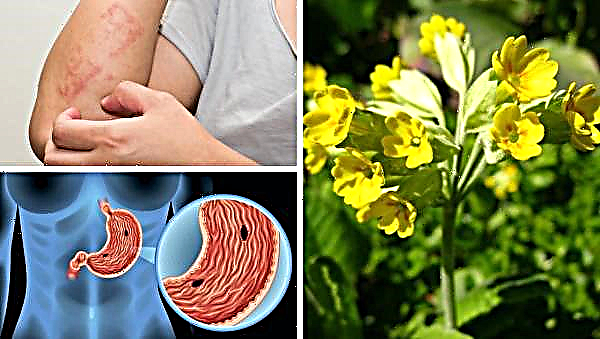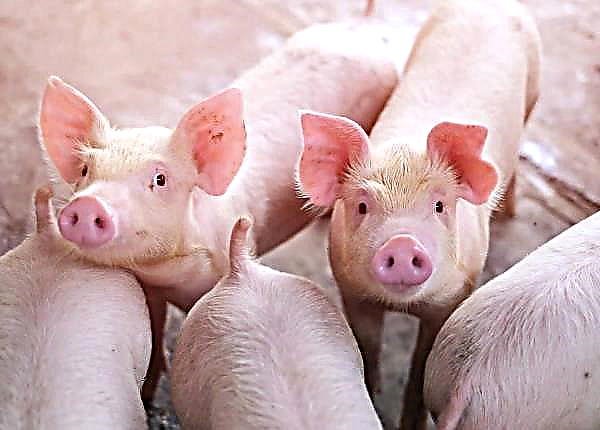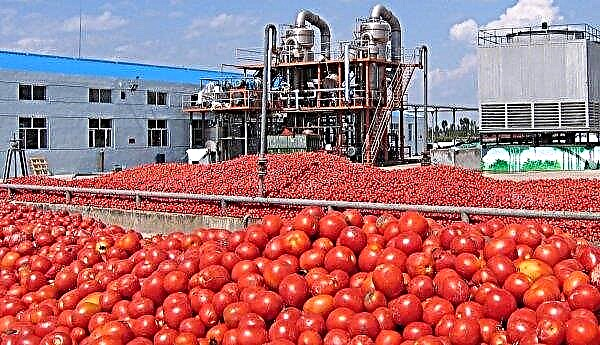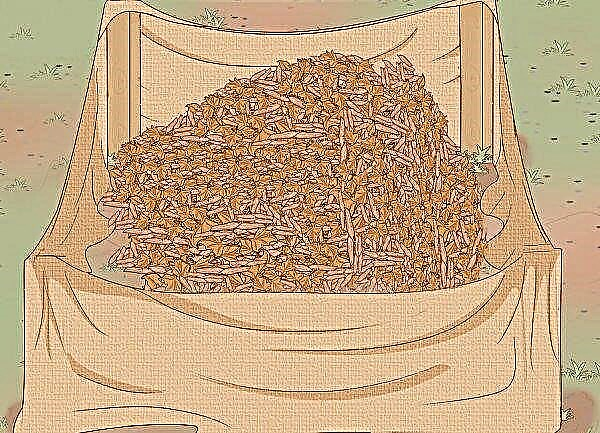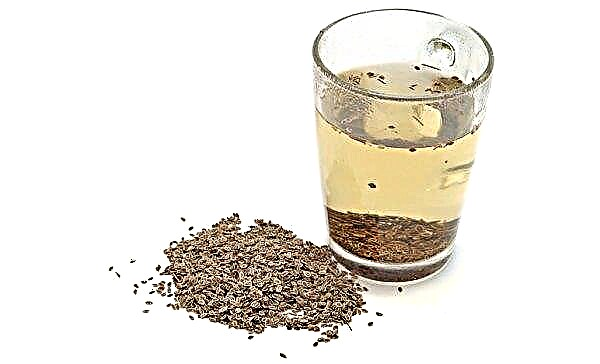Koch's wand is dangerous for cattle. One of the varieties of tuberculosis is called bullish, although bulls and cows are susceptible to both the human and bird species of this disease. We learn what kind of disease it is, what are its causes, symptoms, diagnosis and measures taken to detect tuberculosis in the herd.
What is tuberculosis?
This is an infectious disease that causes Koch's wand. Most often, her lungs are affected, but other organs and systems can also be affected. It is dangerous in that it can be transmitted from animals to humans - with meat, milk and dairy products. The danger is also that the disease can proceed latently (asymptomatically).
Did you know? The Babylonian laws, written about 2 thousand years BC, allowed to divorce a wife with tuberculosis. And the ancient Indian laws of Manu forbade the marriage of a girl from a family where there were cases of this disease.
History reference
Scientists have found evidence that animals had this infection 245 million years ago. Ancient manuscripts that have come down to our times indicate the presence of tuberculosis in a very distant past. Symptoms of this disease in humans are described in the Indian Vedas, the works of ancient Greek and Roman healers, and other ancient sources. In some of them, assumptions were made about the infectiousness of this ailment. In 1865, a doctor from France Wilman proved the contagiousness of this disease and the possibility of transmission from person to animal and vice versa. In 1882, Robert Koch, a microbiologist from Germany, who devoted much time and work to the study of tuberculosis, discovered the causative agent of this disease, and after a while - tuberculin, which to this day is used to detect tuberculosis. In 1921, the first tuberculosis vaccine was given to humans.
In 1865, a doctor from France Wilman proved the contagiousness of this disease and the possibility of transmission from person to animal and vice versa. In 1882, Robert Koch, a microbiologist from Germany, who devoted much time and work to the study of tuberculosis, discovered the causative agent of this disease, and after a while - tuberculin, which to this day is used to detect tuberculosis. In 1921, the first tuberculosis vaccine was given to humans.
Economic damage
Livestock farming in the detection of tuberculosis suffer great losses. With this disease, herd productivity decreases, sick animals are slaughtered, costly disinfection is carried out and other measures are taken against the spread of the disease, which also cost money.
Did you know? The damage from cattle tuberculosis over the past 40 years in Russian animal husbandry amounted to almost 85 billion rubles in cash. Of these, 27.4 billion rubles. spent on anti-TB measures.
The causative agent and source of infection
The cause of the disease are mycobacteria Mycobacterium tuberculosis, also called Koch's bacilli. They are very stable and can be found and live in water and soil, where they fall with feces, for a long time. In soil and manure, they can be up to 4 years. The sun's rays kill them in sputum samples in just 72 hours. Now there are three varieties of these bacteria - human, bovine and avian. At the same time, it is noted that they can change and pass into other varieties. The source of infection is a sick animal and its secretions - sputum, bowel movements, milk. Routes of infection - by airborne droplets or through food and drink. Crowding of animals, general grazing, and joint drinking and feeding contribute to the spread of the disease.
The source of infection is a sick animal and its secretions - sputum, bowel movements, milk. Routes of infection - by airborne droplets or through food and drink. Crowding of animals, general grazing, and joint drinking and feeding contribute to the spread of the disease.
Signs and course of the disease
The incubation period lasts 2-6 weeks. With severe forms, attention should be paid to the following:
- shortness of breath and wheezing when breathing;
- weight loss and decreased appetite;
- dryness and inelasticity of the skin;
- copious sputum production;
- temperature increase (about 40 ° C).
 Symptoms also depend on the focus and extent of the lesion. Typically, an infection in cattle settles in the following places:
Symptoms also depend on the focus and extent of the lesion. Typically, an infection in cattle settles in the following places:
- Lungs. The most typical form of tuberculosis with the typical symptoms listed above, transmitted anaerobically or through saliva.
- Intestines. Diarrhea with inclusions of pus and blood, severe exhaustion is added to the usual symptoms. Transmission occurs primarily through feces.
- Udder. The udder, nipples, and also the lymph nodes near them enlarge and harden. The cow feels pain when pressed, and milk is excreted with blood clots. An infection is transmitted through milk.
- Genitals. Intrauterine infection is characterized by miscarriage and inability to conceive. In males, the external genitalia swell and become inflamed. With this form, the transmission of infection is through sexual contact.
- Generalized form. The neglected form, which is characterized by an increase in lymph nodes throughout the body. Many organs are affected, and if the infection has reached the brain, then the disease gives itself out as signs of central nervous system problems (paralysis, etc.).
Important! When generalized, cattle meat is disposed of within 6 hours after slaughter. Also, animals with anthrax are always completely destroyed.
Diagnostics
Since the disease is often hidden and it is not necessary to observe typical symptoms, a tuberculin test is regularly performed on cattle. It can be performed for cattle from the age of 2 months, as well as to make pregnant animals. If the injection site increased after 3 days by more than 3 mm or there is an increase in body temperature at the injection site, then a second test is carried out, and for all cattle.
Video: Allergic method for the diagnosis of cattle tuberculosis
Tuberculin may be reintroduced into the eye or intravenously. With a pronounced reaction, a diagnostic autopsy of the animals is performed. Tuberculinization is performed 2 times a year in the off-season.
Pathological changes
Tuberculosis affects the internal organs, which leads to certain pathological changes. The formation of nodular forms of various parameters occurs - from a few millimeters to 10 cm or more. These formations are dense in structure, representing a combination of calcium salts and connective tissue. At the cross section, they have a layered structure, in the central part there is a mass of a curdled appearance (necrotic tissue).
Such tubercles can be located in different parts of the tubercle bacillus lesion. The lungs are usually affected by the largest formations, and smaller tubercles are observed in the intestines and serous tissues. Tuberculosis neoplasms The following changes in internal organs also occur:
Tuberculosis neoplasms The following changes in internal organs also occur:
- lobar pneumonia;
- necrosis of the lungs. It is often accompanied by severe inflammation with the content of purulent formations;
- suppurations, caverns;
- inflammatory processes in the lymph nodes;
- the mucosa is affected by ulcers;
- changes in the liver, heart and kidneys, as well as bone marrow.
Treatment
Unfortunately, at the moment there are no effective medicines against cattle tuberculosis that would help completely defeat such a disease. Sick animals are slaughtered and take anti-TB measures.
Farms are classified as successful or not, depending on the result of veterinary checks and studies. Dysfunctional farms receive certain restrictions from the local administration that will interfere with the growth and spread of tuberculosis. The control and responsibility for the implementation of such restrictions and the implementation of measures to prevent the spread of the disease is carried out by the relevant veterinary services. To carry out certain health measures, the following methods are chosen:
To carry out certain health measures, the following methods are chosen:
- Regular (every 2 months) laboratory tests and studies to identify infected animals. Then they are sent for slaughter. Such measures are carried out until all results for the detection of tuberculosis are negative. In this case, the restrictions are removed, and the economy receives the status of prosperous.
- Complete replacement of the herd with simultaneous complete disinfection of the livestock premises. It is carried out when the results of studies revealed more than 15% of sick individuals. Quarantine is announced, the premises are thoroughly cleaned, floors are removed and disposed of, disinfection is being carried out. If instead of the floor in the detention room there is simply earth, then the topsoil to a depth of 15–20 cm is removed and taken out of the farm to the place indicated by the veterinary service. All garbage, manure from the places of keeping, herd maintenance equipment are also disposed of. After carrying out these measures, they make a new floor, feeding troughs and drinking bowls, and purchase new equipment. Then re-disinfection. Then laboratory tests are carried out to identify the presence of pathogens of tuberculosis. After laboratory tests confirm the absence of infection, quarantine is removed from the farm and a new herd can be purchased. Procurement is carried out from prosperous farms with appropriate tests for infection.

Is it possible to drink milk and eat meat of sick animals?
The causative agent of tuberculosis can exist in milk for 10 days, in a sour-milk environment (kefir, fermented baked milk, yogurt) can last up to 3 weeks. In cheeses and butter, the tuberculosis bacillus can be active for up to a year, and ice cream can ensure that the infection lasts up to 6.5 years.
Milk and meat infected with tubercle bacillus are a threat to human health, and it is strictly forbidden to eat them. The meat of animals with a severe form of damage is disposed of. If the defeat of tuberculosis is small, and the animal is well-fed, then the meat is given for cooking.Important! To avoid the spread of tubercle bacillus into the body, purchase dairy products from certified sellers in specialized stores, and not in natural markets.
 The milk from the infected herd is boiled for 10 minutes and is used only for fattening animals on the farm. Milk from healthy cows, but from a poor farm, is processed by pasteurization at a temperature of 90 ° C for at least 5 minutes, and at 85 ° C for at least 30 minutes. It is possible to supply pasteurization cream to dairies.
The milk from the infected herd is boiled for 10 minutes and is used only for fattening animals on the farm. Milk from healthy cows, but from a poor farm, is processed by pasteurization at a temperature of 90 ° C for at least 5 minutes, and at 85 ° C for at least 30 minutes. It is possible to supply pasteurization cream to dairies.Tuberculosis vaccine
To form an immune system against tuberculosis pathogens, a BCG vaccine is used for vaccinations. Vaccinations are done using vaccine injections with an interval of 14 days according to the following recommended standards: toxoid - 0.05-0.07 mg / kg; BCG vaccine - 0.05-0.1 mg / kg of cattle weight.
Did you know? The first tuberculosis vaccine was created in 1919 by the French Albert Calmette and Camille Guerin. Initially, they began to introduce it to people.
Other preventive measures
There are also the following measures for the prevention of tuberculosis in cattle:
- adhere to all hygiene standards when keeping, feeding, transporting animals;
- to purchase only high-quality feed from reliable manufacturers;
- register with the veterinary organization all individuals;
- upon purchase of cattle, ensure quarantine conditions for the acquired animals and conduct the necessary veterinary examination;
- at the slightest sign of any disease, consult a veterinarian;
- obtain all permits from the sanitary and veterinary services for the purchase, any movement of cattle, as well as for the use of certain pastures, sale of dairy and meat products;
- 2 times a year to carry out preventive veterinary examination;
- provide independent research in identifying pathogens of infection;
- within 14 days to take to slaughter sick animals when a disease is detected by the veterinary service;
- not allow workers to work on the farm if they have a positive reaction to this disease;
- when acquiring a farm, it is imperative to disinfect all premises and equipment;
- regular disinfection and cleaning of premises, cleaning of feeders, drinking bowls and other equipment, pest control (rodents, ticks and others);
- compliance with all recommendations and restrictions of the veterinary service in the detection of tubercle bacillus on the farm;
- it is necessary to equip veterinary sanitary points;
- when preparing and storing feed, observe all the rules of sanitary standards;
- keep animals in aired, dry rooms, as dampness contributes to the onset of the disease;
- to detect the initial degree of the disease, take and take samples from meat after slaughter.
 Tuberculosis in animals is not treated; it can cause great damage to the cattle farm. Therefore, it is necessary to vaccinate livestock, regularly make tuberculin tests and take other preventive measures.
Tuberculosis in animals is not treated; it can cause great damage to the cattle farm. Therefore, it is necessary to vaccinate livestock, regularly make tuberculin tests and take other preventive measures.


